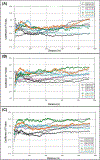Understanding wear behavior of 3D-Printed calcium phosphate-reinforced CoCrMo in biologically relevant media
- PMID: 33965811
- PMCID: PMC8205995
- DOI: 10.1016/j.jmbbm.2021.104564
Understanding wear behavior of 3D-Printed calcium phosphate-reinforced CoCrMo in biologically relevant media
Abstract
Recent advances in the processing of wear-resistant calcium-phosphate reinforced CoCrMo composites for articulating surface applications has necessitated further investigation of performance in biological conditions relevant to patient applications. To this end, CoCrMo composites containing calcium phosphate in the form of hydroxyapatite (HA) were manufactured to study the influence of the reinforcing phase on the tribofilm formation in biologically-relevant conditions. The CoCrMo-HA composites were processed using a laser engineered net shaping (LENS™) additive manufacturing (AM) system with three distinctive compositions: CoCrMo-0%HA, CoCrMo-1%HA, and CoCrMo-3%HA. Extensive wear testing of the CoCrMo-HA composites was carried out in DMEM (cell media) and DMEM + Hyaluronic acid (found naturally in synovial fluid). Wear tests were performed at loads ranging from 5N to 20N, and wear media was measured post-test using ICP-MS techniques to release Co and Cr ions. During testing, all coefficients of friction remained in the 0.15-0.25 range, which was lower than the previously reported 0.50-0.75 range in DI water, indicating that the DMEM + hyaluronic acid media plays a significant role in reducing frictional contact. At loads higher than 15N, the HA-tribofilm exhibited a breakdown resulting in higher wear rates but still lower overall ion release than the CoCrMo control composition. Our results indicate that CoCrMo alloys with HA addition can significantly reduce wear rates and ion release even in the presence of naturally-occurring synovial-fluid friction-reducing media.
Keywords: Cobalt-chromium-molybdenum; Hydroxyapatite; Laser additive manufacturing; Tribofilm; Wear.
Copyright © 2021 Elsevier Ltd. All rights reserved.
Conflict of interest statement
Conflict of interest
None.
Figures






Similar articles
-
Laser processed calcium phosphate reinforced CoCrMo for load-bearing applications: Processing and wear induced damage evaluation.Acta Biomater. 2018 Jan 15;66:118-128. doi: 10.1016/j.actbio.2017.11.022. Epub 2017 Nov 8. Acta Biomater. 2018. PMID: 29128529
-
Hydroxyapatite-Reinforced, Infection-Resistant CoCrMo-3Cu for Load-Bearing Implants.ACS Appl Mater Interfaces. 2025 Aug 6;17(31):44199-44211. doi: 10.1021/acsami.5c08994. Epub 2025 Jul 23. ACS Appl Mater Interfaces. 2025. PMID: 40696891
-
Additively manufactured calcium phosphate reinforced CoCrMo alloy: Bio-tribological and biocompatibility evaluation for load-bearing implants.Addit Manuf. 2019 Aug;28:312-324. doi: 10.1016/j.addma.2019.04.020. Epub 2019 May 2. Addit Manuf. 2019. PMID: 31341790 Free PMC article.
-
Tribological behaviour of 3D printed materials for small joint implants: A pilot study.J Mech Behav Biomed Mater. 2022 Aug;132:105274. doi: 10.1016/j.jmbbm.2022.105274. Epub 2022 May 23. J Mech Behav Biomed Mater. 2022. PMID: 35636120
-
Distribution of cobalt chromium wear and corrosion products and biologic reactions.Clin Orthop Relat Res. 1996 Aug;(329 Suppl):S233-43. doi: 10.1097/00003086-199608001-00020. Clin Orthop Relat Res. 1996. PMID: 8769337 Review.
Cited by
-
Graphene and its Derivatives for Bone Tissue Engineering: In Vitro and In Vivo Evaluation of Graphene-Based Scaffolds, Membranes and Coatings.Front Bioeng Biotechnol. 2021 Sep 29;9:734688. doi: 10.3389/fbioe.2021.734688. eCollection 2021. Front Bioeng Biotechnol. 2021. PMID: 34660555 Free PMC article. Review.
References
-
- Alvarez-Vera M, Ortega-Saenz JA, Hernandez-Rodríguez MAL, 2013. A study of the wear performance in a hip simulator of a metal-metal Co-Cr alloy with different boron additions. Wear. 10.1016/j.wear.2013.01.085 - DOI
-
- ASTM Standard G-133-05, 2016. Test Method for Linearly Reciprocating Ball-on-Flat Sliding Wear. ASTM International, West Conshohocken, PA, PA. 10.1520/G0133-05R10.2 - DOI
Publication types
MeSH terms
Substances
Grants and funding
LinkOut - more resources
Full Text Sources
Other Literature Sources

